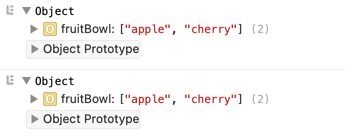console.log() holds a reference to an object, not a copy of it
When you view an array/object with console.log(), you see the contents at the time you expand it, not as it existed when you called console.log().
I was having a weird issue with some JavaScript. I was loading a JSON object and logging it to the console in my browser dev tools, but it didn’t match the object that was defined in my code. What was going on?!
I started commenting out the rest of my code, and I discovered that code that appears after the console.log() was affecting what got printed in my browser. Huh!
Here’s a snippet that illustrates the issue:
<script>
window.addEventListener("DOMContentLoaded", function() {
var kitchen = {
fruitBowl: ['apple', 'banana', 'cherry'],
};
console.log(kitchen); /* I expected a/b/c here but get a/c */
kitchen.fruitBowl.splice(1, 1);
console.log(kitchen); /* Here I expect a/c */
});
</script>
And here’s what gets logged if I expand the objects in my browser console:

As best I can tell, what’s happening is that console.log() is getting a reference to the object, but it isn’t being expanded until later. I’m seeing the value at the point it was expanded, not when I originally called console.log(), so any subsequent modifications to the value will be reflected in what I see in my browser console.
There are two things I can do to avoid this biting me again:
Create a copy of an object before I
console.log()it. This could mean cloning it with{...object}or[...array], or turning it into a string withJSON.stringify(…). This means it won’t be affected by subsequent changes to the value.(You need to do a “deep” clone here, because JavaScript will try to be efficient and reuse values where possible. A “shallow” clone may still be affected by other changes to the value.)
Treat JavaScript values as immutable. This is a good habit I’ve got into from writing Scala, and it’s what I do most of the time, which is why I didn’t realise sooner what was going on. It’s fairly unusual for me to modify a JavaScript object after it’s defined, so it didn’t occur to me that might be an issue.